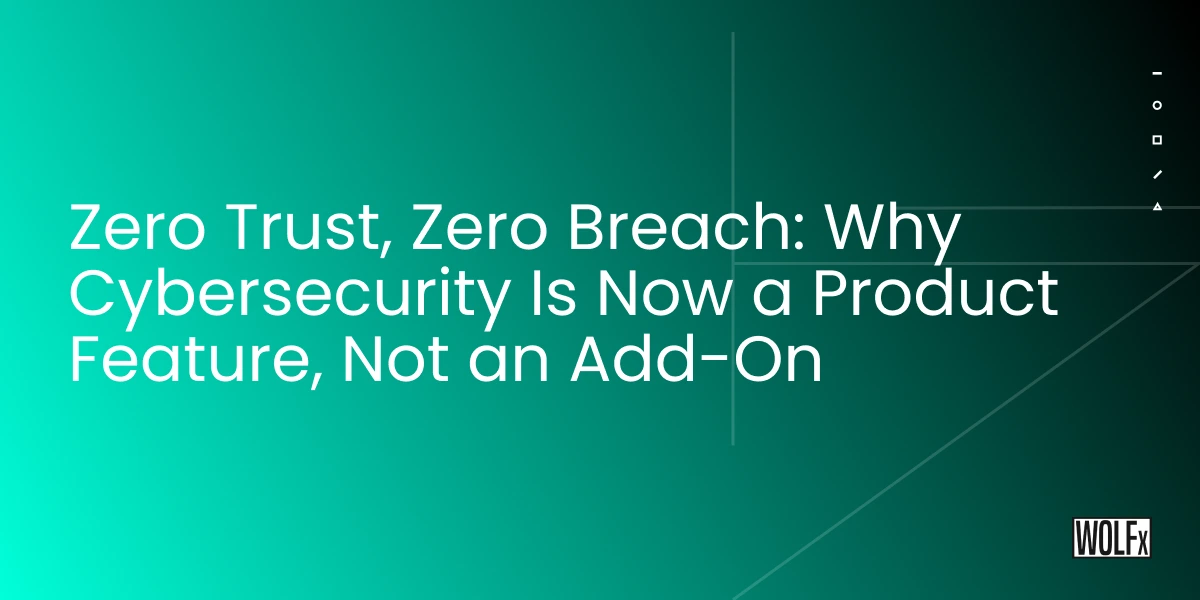Introduction: The New Reality of Trust in Tech
Security is no longer a backend function hidden somewhere in the infrastructure. It has become a core part of the product experience. With breaches happening around the world every few seconds, cybersecurity in product design is now directly tied to brand reputation. Users do not look for a lock icon or a policy page. They assume that everything they use already follows a security-by-design mindset.
This expectation has transformed the entire digital ecosystem. Startups, enterprises, and SaaS platforms now understand that trust is not something you earn after launch. Trust must be built into the product from the very first click. The rise of the Zero Trust architecture and the Zero Trust security model shows a clear shift. Security is no longer a defensive measure. It is a product differentiator that influences every decision a user makes.
The Pain: The Hidden Cost of Treating Security as an Afterthought
The cost of data breaches has increased dramatically. A single weak point can destroy user trust instantly. Yet many companies still treat security as something they will handle later. This approach creates problems that are expensive to fix and impossible to hide.
Many teams launch products without secure architecture. Developers focus on features and forget to integrate protection early in the secure software lifecycle. Delayed security integration leads to vulnerabilities that attackers can exploit. The result is a breach of user trust that takes years to repair.
There are also regulatory risks. GDPR compliance in tech, ISO 27001 product compliance, SOC 2 data security, and global data protection standards are stricter than ever. Startups face challenges when they ignore compliance or overlook data privacy risks. Cybersecurity gaps in SaaS products create a domino effect that affects investors, customers, and the brand itself.
The real pain is simple. Security afterthought in tech hurts more than missing a feature. It damages reputation, affects customer confidence in technology, and weakens the entire product value proposition.
The Shift: From Add Security Later to Build with Security First
A major mindset shift is happening in the industry. Modern teams are moving toward a security-first approach where protection is baked into the product from day one. Security-first design is now seen as a mark of maturity and responsibility.
Companies adopting the Zero Trust framework treat every request as unverified. This eliminates blind trust inside networks and helps prevent lateral movement during an attack. Investors and enterprise buyers now evaluate a product by asking how secure it is before asking what it can do. They want to know about identity and access management, multi-factor authentication, endpoint detection and response, vulnerability management, and software supply chain security.
The modern tech buyer understands that product security directly affects speed, scale, and innovation. Cybersecurity in software development has become a growth enabler, not a blocker.
The Modern Buyer’s Expectation: Trust by Design
Today’s technology buyers expect trust by design. They care about how safe a product feels the moment they start using it. They want fast performance, clean user experience, and invisible protection that works in the background.
Key expectations include
• Trust leads to retention and long-term loyalty
• Simple experiences backed by strong cybersecurity
• Full transparency in data handling and access control
• Proof of compliance and consistency in zero breach history
Digital trust and security now influence buying decisions more than UI or feature count. Modern buyers want proactive cybersecurity strategy, privacy-first development, and clear communication about risk management. Trust-driven product development has become the new baseline for digital transformation and security.
The Product Philosophy: Security as a Core Feature
Security is no longer an additional box to tick. It is a core product philosophy. Teams that understand this build safer, smarter, and more resilient systems.
Core principles include
• Secure by default thinking at every step of design and development
• Least privilege access, where systems and users only get what they need
• Continuous verification of every identity and request
• Human awareness and training so teams think securely
• Built-in compliance aligned with global security frameworks
This mindset helps companies integrate Zero Trust into products naturally. It also strengthens the entire product lifecycle and protects against internal threats, weak access control, and microsegmentation failures.
Case Insight: What Happens When Security Leads the Product
Real world examples consistently show how a security-first approach creates measurable business impact.
A fintech platform that used Zero Trust architecture from the earliest stage reduced incident response costs by more than half. A SaaS product that adopted continuous monitoring maintained near-perfect uptime with zero major breaches. A healthcare app that added secure APIs and identity management saw a sharp rise in user adoption because the experience felt safe and reliable.
These examples prove that cybersecurity-driven innovation contributes directly to customer trust and long term growth.
The Payoff: Why Zero Trust Means Infinite Confidence
When security becomes a product feature, everything else improves. Speed increases because developers spend less time fixing vulnerabilities later. Scale becomes easier because secure digital product development creates strong foundations. Stability improves because threats are caught early.
Security is not a cost center anymore. It is a competitive advantage. It strengthens the trust-first tech strategy. It raises the total cost of ownership in a positive way because companies save more in the long run. It becomes a natural extension of user experience and a pillar of customer trust.
This is why more companies now treat Zero Trust as the starting point for their entire cybersecurity product strategy.
Conclusion: The Future Belongs to the Secure
The future of digital products will be shaped by those who treat security as an essential experience. Trust-built products will outperform trust-earned products. Businesses that invest in resilient and secure digital ecosystems today will lead the markets of tomorrow.
Zero Trust is not just a model. It is a mindset. Zero breach is not a dream. It is a responsibility. Security is not something users see. It is the reason they stay.

